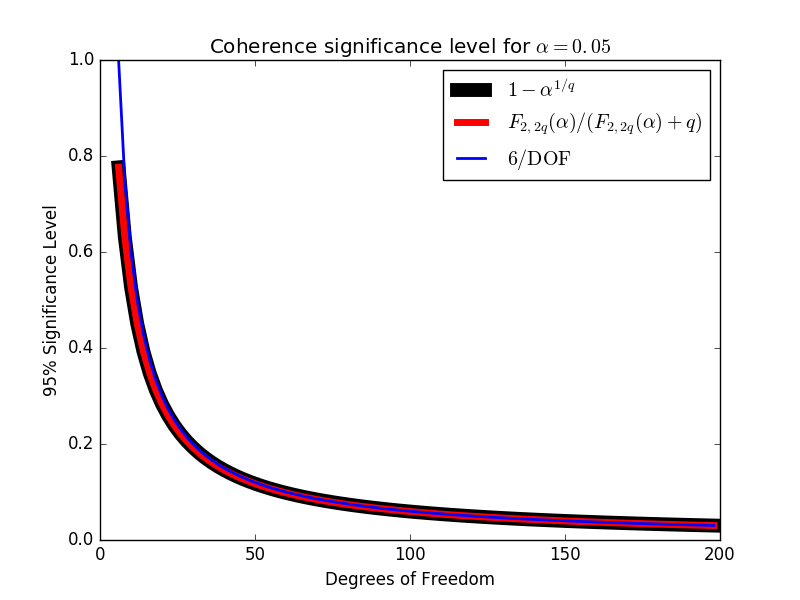Great question! I've been grappling to determine how to calculate statistical significance of coherence for several days. This question helped me find some key references I hadn't previously located!
One detail regards whether you're talking about "coherence" or "magnitude-squared coherence". The first resource uses the former and the second uses the latter. I generally prefer the latter:
$$C_{x,y}(\omega)= \frac{|\langle{X^*(\omega)Y(\omega)}\rangle|^2}{\langle|X(\omega)|\rangle^2\langle|Y(\omega)|\rangle^2}$$
Where $X(\omega)$ is the fourier transform of $x(t)$, and $\langle \rangle$ denotes an ensemble average of $n$ independent ensembles. Obviously the plain "coherence" is the square root of what is defined above.
The significance level of this magnitude-squared coherence as defined by the two resources is:
$$L_1(\alpha, q) = 1-\alpha^{1/q}$$
$$L_2(\alpha, q) = F_{2,2q}(\alpha)/(F_{2,2q}(\alpha)+q) $$
Where $\mathrm{DOF} = 2n = 2 ( q + 1 )$, and $F$ is the inverse-CDF (percent point function) of the F-statistic. Also, just FYI, the second formulation can also be found in Priestley 1981 page 706.
The following Python code implements the two approaches for $\alpha=0.05$ (i.e. a 95% significance level):
import numpy as np
import scipy.stats as st
alpha = 0.05
p = 1 - alpha
dof = np.arange(5, 100)
n = dof / 2.
C_1 = 1 - alpha ** (1. / (n - 1))
fval = st.f.ppf(p, 2, dof - 2)
C_2 = fval / (n - 1. + fval)
Plotting the two functions shows that they are apparently identical:
import matplotlib.pyplot as plt
ax = plt.gca()
ax.plot(dof, C_1, 'k-', lw=10, label=r'$1-\alpha^{1/q}$')
ax.plot(dof, C_2, 'r-', lw=5, label=r'$F_{2,2q}(\alpha)/(F_{2,2q}(\alpha)+q)$')
ax.plot(dof, 6. / dof, 'b-', lw=2, label=r'$6/d$')
ax.set_xlabel('Degrees of Freedom')
ax.set_ylabel('{:0.0f}% Significance Level'.format(100 * p))
ax.legend()
ax.set_title(r"Coherence level for $\alpha=0.05$")

I compared $L_1$ (black) and $L_2$ (red) for several different values of $\alpha$ and they always agree (their difference was always $O(10^{-16})$). I didn't bother doing the algebra to show that $L_1=L_2=L$, but perhaps someone else will find that to be an interesting undertaking?
Lastly, I've included the approximation: $L(\alpha=0.05)\approx6/\mathrm{DOF}$ (blue). I got this from U. Washington Applied Physics Lab professor Jim Thomson, which he apparently got from legendary oceanographer Carl Wunsch. It appears to be a very good approximation when $\alpha=0.05$ and $\mathrm{DOF} > 20$ or so. I'd be interested to see the algebra that shows that:
$$\lim_{\mathrm{q}\rightarrow\infty}L(1/20,q) = \frac{6}{\mathrm{DOF}}$$

